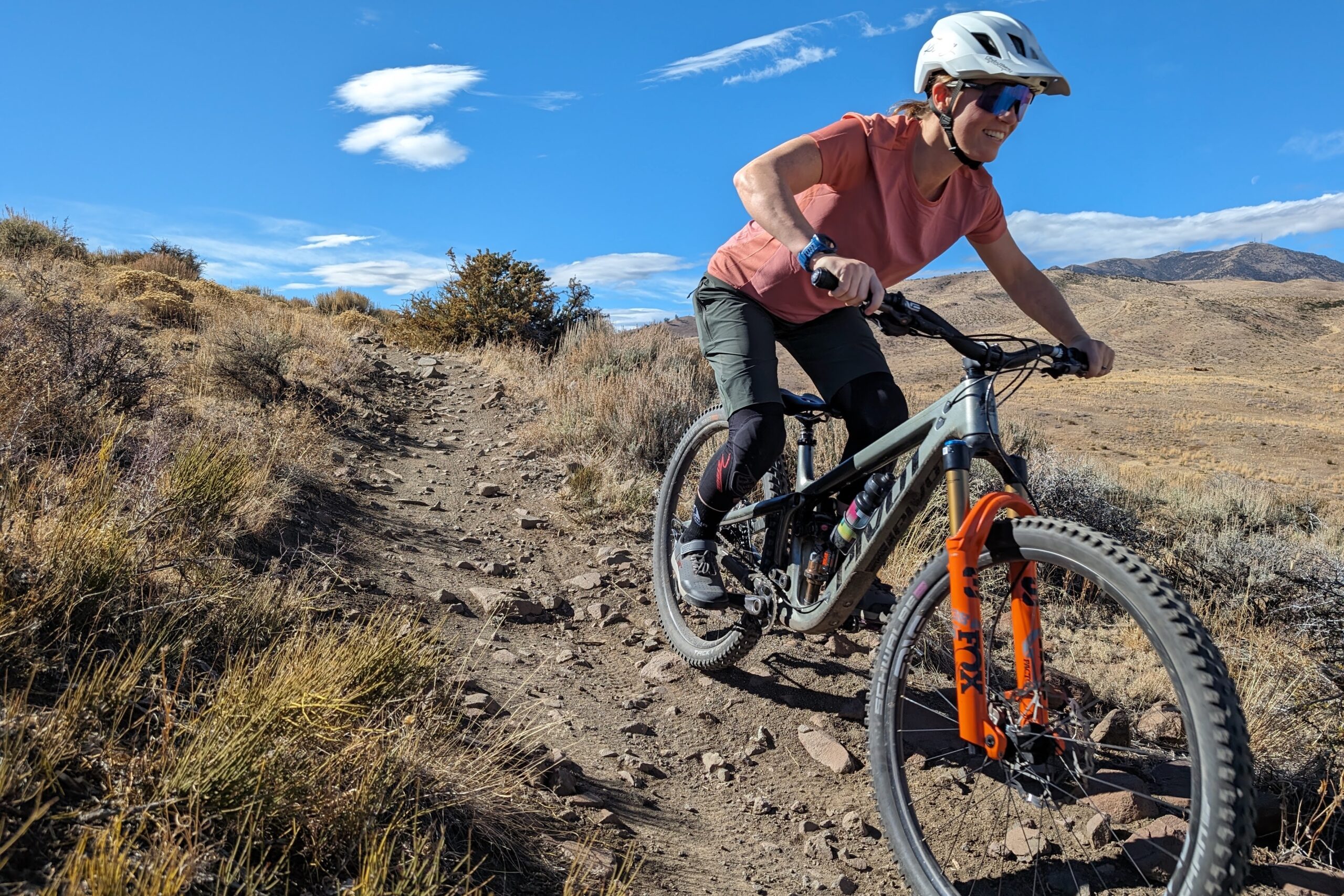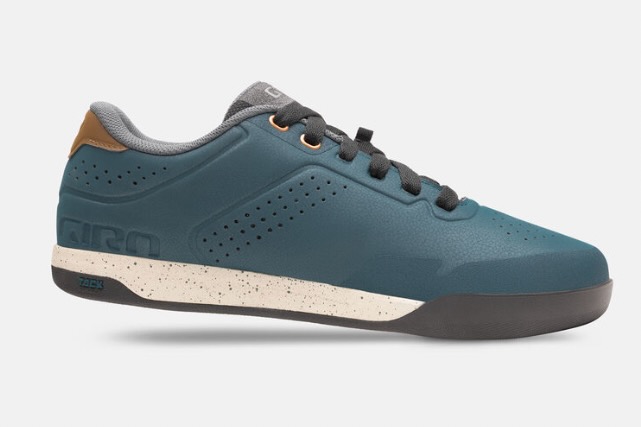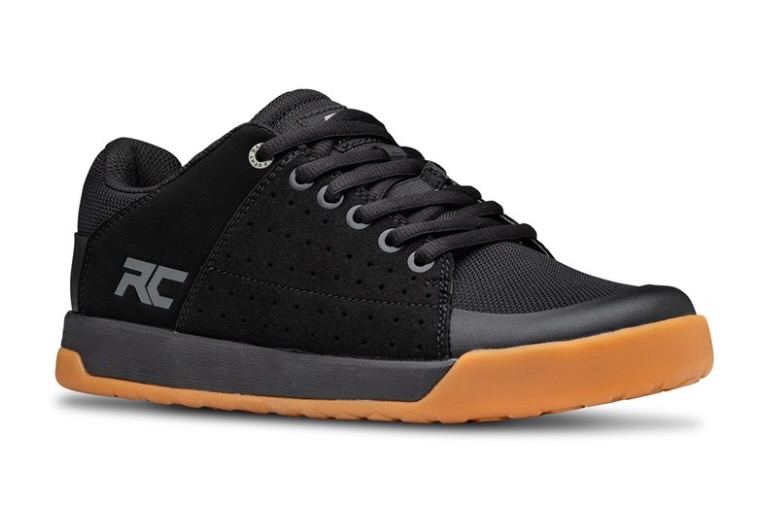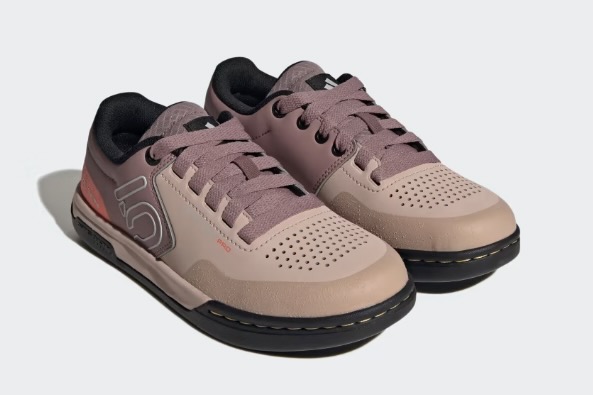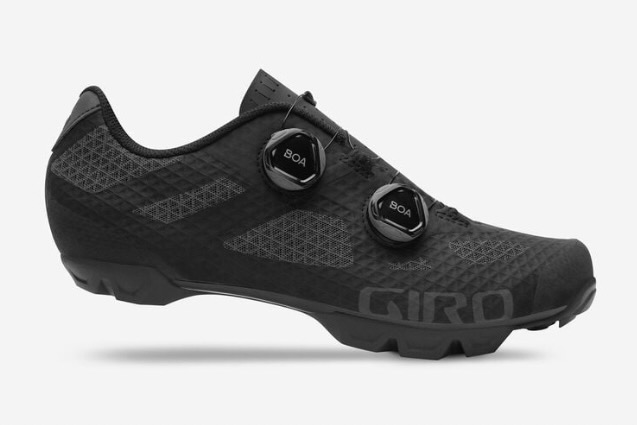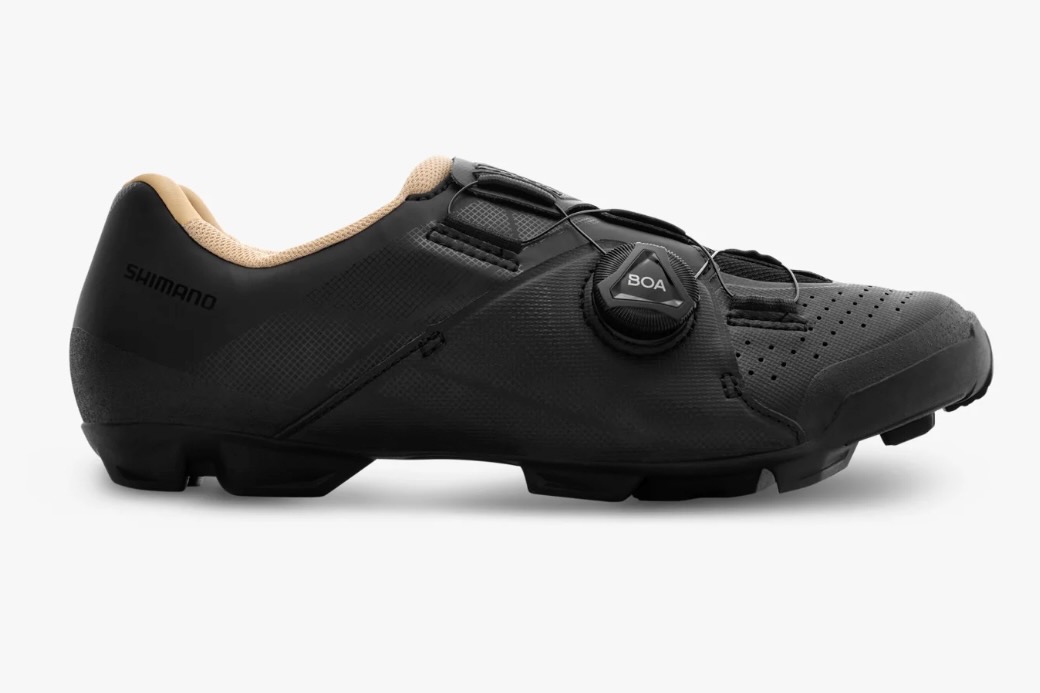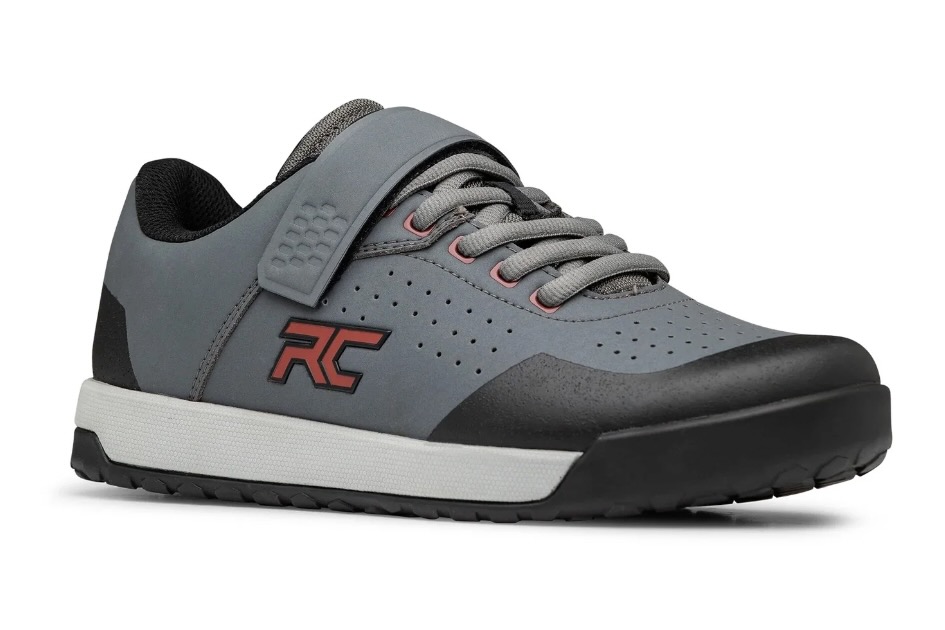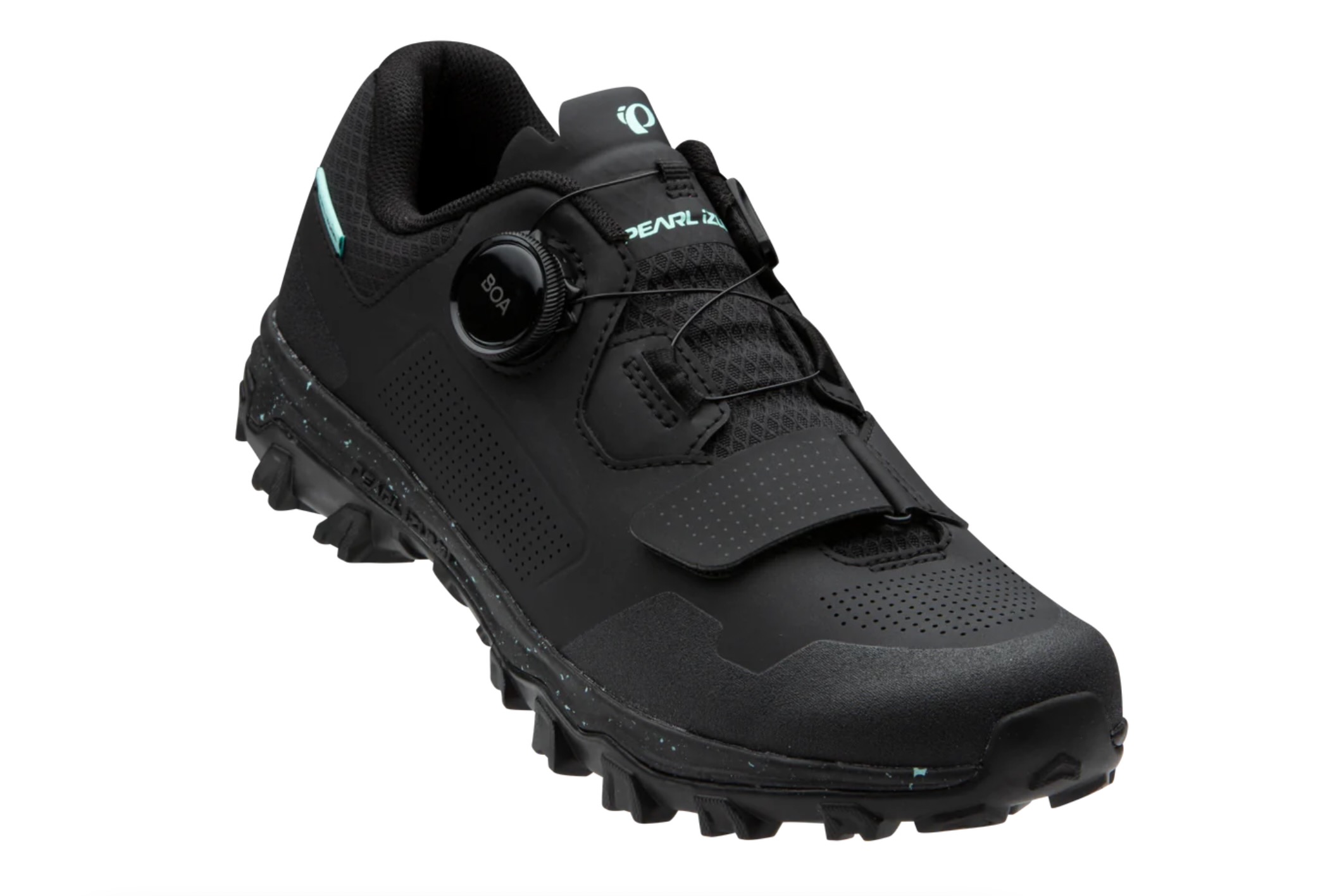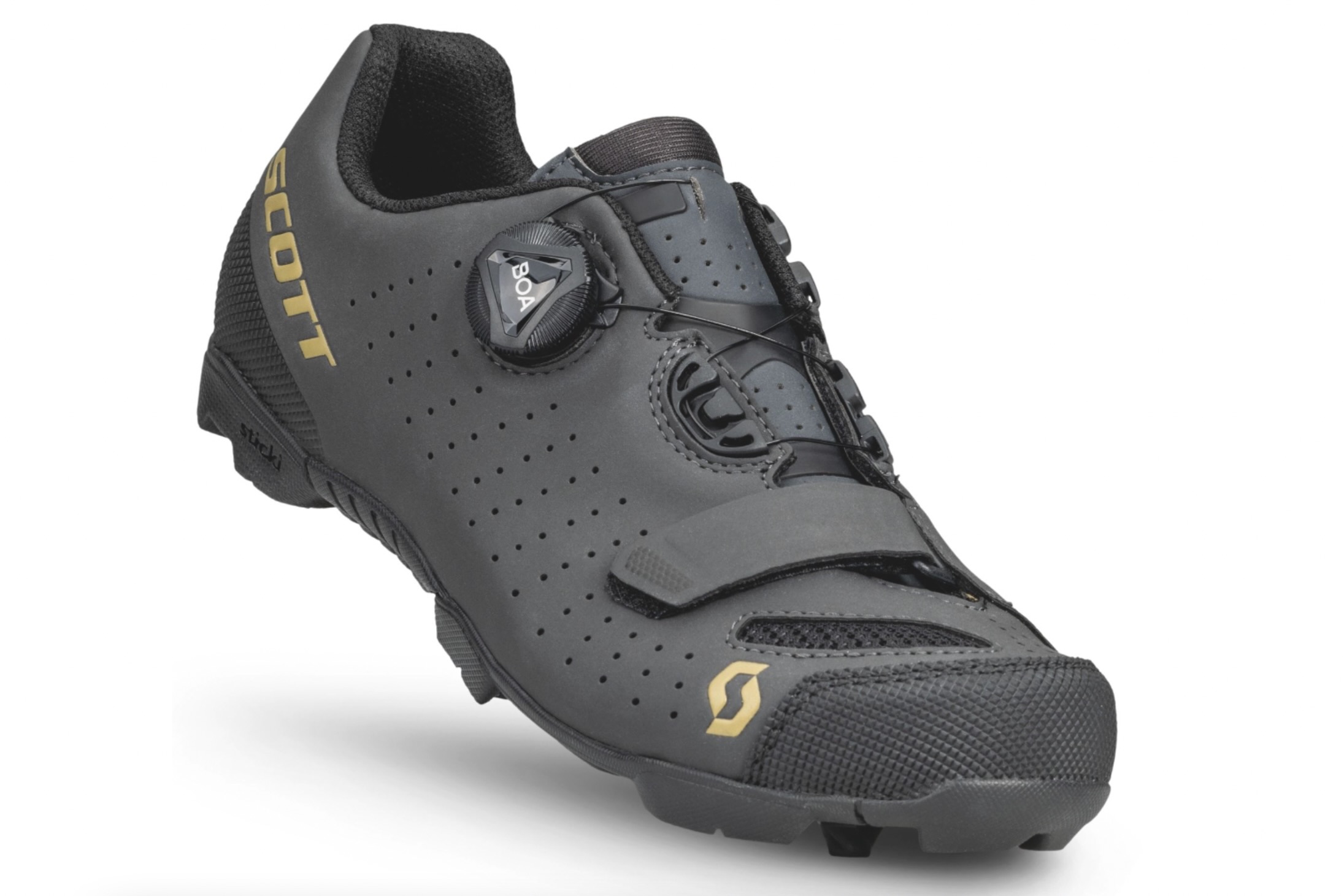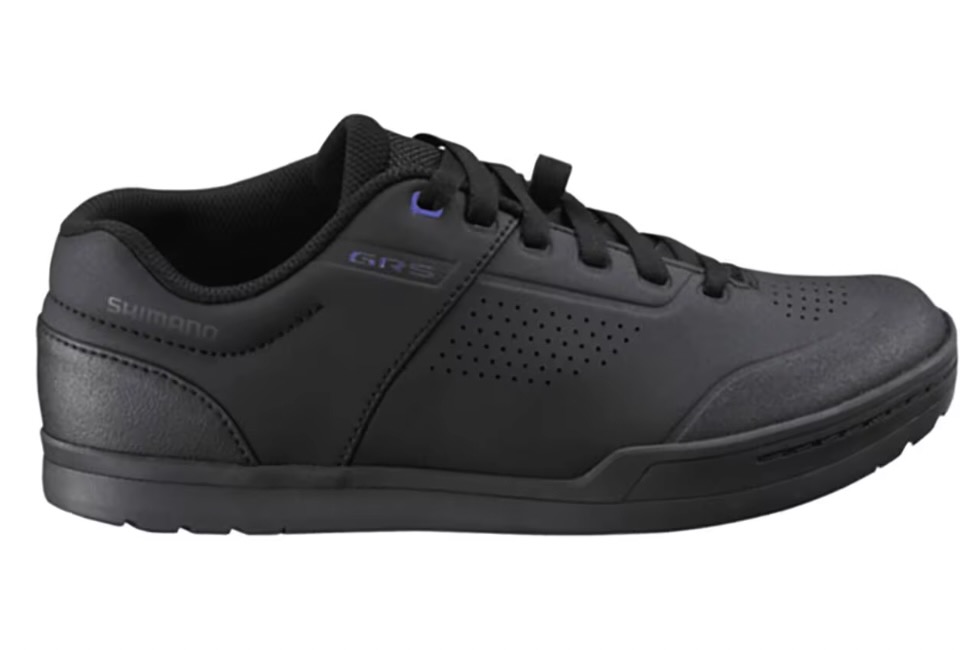Our shoes serve as the important connection between our feet and the pedals and they are critical when it comes to our comfort, control, and efficiency on the bike. While they can easily be overlooked, the right pair of women’s mountain bike shoes can enhance our enjoyment and performance every time we ride.
Whether you clip in or ride flat pedals, your shoes need to interface well with your pedals and provide support, stability, foot protection, and comfort for long and short rides. Of course, the performance characteristics you look for in a shoe can vary as widely as the different styles of mountain biking, and there are options designed to meet the range of needs across the spectrum. But with so many models on the market, we know that finding the right mountain bike shoes can be a challenge.
To help, we gathered up 9 of the best clipless and flat pedal women’s mountain bike shoes on the market and tested them for months to see how they perform, and most importantly, how they compare to each other. Whether you’re looking for a lightweight clipless shoe to maximize your efficiency or a grippy flat pedal shoe to keep your feet glued to the pedals, we’ve got recommendations to take your rides to the next level.
Our favorite flat pedal and clipless women’s mountain bike shoes are listed below. To see the models we tested at a glance, check out our comparison chart. If you need help deciding what’s right for you, our buying advice goes over important considerations and our FAQ section provides answers to common questions. And, if you’d like to see more options, we’ve tested the best unisex and men’s clipless mountain bike shoes and flat pedal mountain bike shoes too.
The Best Women’s Mountain Bike Shoes of 2024
- Best Overall Flat Pedal Women’s Mountain Bike Shoes: Giro Latch Women’s
- Best Budget Flat Pedal Women’s Mountain Bike Shoes: Ride Concepts Livewire Women’s
- Runner-Up Best Flat Pedal Women’s Mountain Bike Shoes: Five Ten Freerider Pro Women’s
- Best Overall Clipless XC Women’s Mountain Bike Shoes: Giro Sector Women’s
- Best Budget Clipless XC Women’s Mountain Bike Shoes: Shimano XC3 Women’s
- Best Clipless Women’s Mountain Bike Shoes for Aggressive Riding: Ride Concepts Hellion Clip Women’s
- Best Clipless Women’s Mountain Bike Shoes for Adventure Riding: Pearl Izumi X-Alp Summit Women’s
Giro Latch Women’s
- MSRP: $150
- Weight (per shoe): 319.5 grams (42 EU/ 9.5 US Women's)
- Pedal Type: Clip
- Outsole Material: Tack Rubber
- Upper Material: Microfiber
- Midsole: Mute Foam
- Closure: Laces with elasticized lace keeper
- Sizes Available: 36 – 43 EU (whole sizes only)
Pros
- Grippy sole
- Relatively lightweight
- Balanced sole stiffness
- Mute Foam midsole dampens vibration
Cons
- None
Ride Concepts Livewire Women’s
- MSRP: $110
- Weight (per shoe): 340 grams (41 EU/ 9.5 US Women's)
- Pedal Type: Clip
- Outsole Material: DST 6.0 Max Grip
- Upper Material: Synthetic with anti-abrasion mesh
- Midsole: EVA
- Closure: Laces with elasticized lace keeper
- Available Sizes: 5 – 10 US Women's (whole and half sizes)
Pros
- Solid pedal grip
- Good toe protection
- Breathable
- Reasonable price
Cons
- Sizing runs a little small – size up a half size
- Low-volume fit may not work for all riders
- Not very water-resistant
Five Ten Freerider Pro Women’s
- MSRP: $160
- Weight (per shoe): 334 grams (9 US Women's/41.5 EU)
- Pedal Type: Clip
- Outsole: Stealth S1 rubber
- Upper Material: Synthetic
- Midsole: EVA
- Closure: Laces
- Sizes Available: 5 – 11 US Women's (whole and half sizes)
Pros
- Grippy Stealth rubber soles
- Tough and weather resistant synthetic uppers
- Well balanced sole stiffness
- Slightly larger size range than some other brands
Cons
- Not the best traction for hike a bikes in loose or slippery conditions
- Roomier toe box – runs a little large – check size chart
- Soles show wear more quickly than others
Giro Sector Women’s
- MSRP: $240
- Weight (per shoe): 325 grams (9.5 US Women's/41.5 EU)
- Pedal Type: Clip
- Outsole: Dual-injected rubber tread knobs
- Upper Material: One-piece Synchwire upper with thermo-bonded exo-structure
- Midsole: Carbon composite plate
- Closure: Dual Boa L6 dials
- Sizes Available: 36 – 43 EU (half sizes 37.5 – 42.5)
Pros
- Excellent breathability
- Stiff soles – efficient pedaling
- Versatile – would be great for gravel riding too
- Boa dials make for easy on/off ad adjustments
Cons
- Virtually no water resistance
- Limited foot protection
- More expensive
Shimano XC3 Women’s
- MSRP: $125
- Weight (per shoe): 311 grams (9.5 US Women's/42 EU)
- Pedal Type: Clip
- Outsole: Rubber
- Upper Material: Seamless, perforated synthetic leather composite
- Midsole: Lightweight glass fiber reinforced nylon
- Closure: Boa L6 dial
- Sizes Available: 36 – 44 EU (whole sizes only)
Pros
- Glove-like fit
- Lightweight
- Reasonable price
Cons
- Low volume may not work for everyone
- No half sizes
Ride Concepts Hellion Clip Women’s
- MSRP: $150
- Weight (per shoe): 427 grams (9.5 US Women's/41 EU)
- Pedal Type: Clip
- Outsole: Clip Grip
- Upper Material: Microfiber
- Midsole: EVA foam with RC PowerDrive nylon shank
- Closure: Laces and upper velcro strap
- Sizes Available: 5 – 10 US Women's (whole and half sizes)
Pros
- Flat pedal shoe style in a clipless shoe
- Good foot protection
- Fairly weather resistant
- Durable soles and uppers
Cons
- Heaver weight
- Not super breathable
- Soles don't have the best hiking grip
Pearl Izumi X-Alp Summit Women’s
- MSRP: $150
- Weight (per shoe): 369 grams (42 EU)
- Pedal Type: Clip
- Outsole: Vibram ECOSTEP rubber
- Upper Material: Seamless, perforated synthetic
- Midsole: Nylon composite
- Closure: L6 Boa dial with lower velcro strap
- Sizes Available: 36 – 43 EU (whole sizes only)
Pros
- Good hiking grip
- Good for adventurous riding with lots of walking
- Comfy fit
Cons
- Forefoot may be a little roomy for those with narrow feet
- Middle of the road sole stiffness
Scott MTB Comp Boa Women’s
- MSRP: $120
- Weight (per shoe): 358 grams (9.5 US Women's/41.5 EU)
- Pedal Type: Clip
- Outsole: Sticki rubber
- Upper Material: Lightweight Polyurethane – Polyester
- Midsole: Nylon Composite – Glass Fiber Composite
- Closure: Boa L6 dial and lower velcro strap
- Sizes Available: 36 – 42 EU (whole sizes only)
Pros
- Good power transfer
- Breathable
- Large range of cleat adjustability
- Reasonable price
Cons
- "Sport" fit is high volume in the toe box
- MSRP: $115
- Weight (per shoe): 363 grams (42 EU/ 9.5 US Women's)
- Pedal Type: Flat
- Outsole: Shimano rubber
- Upper Material: Synthetic
- Midsole: not specified
- Closure: Laces with elastic lace retainer
- Sizes Available: 36 – 44 EU (whole sizes only)
Pros
- Reasonable price
- "Volume last" is good for those with wider feet
- Good off-the-bike traction and walkability
- Toe and ankle protection
Cons
- Rubber sole is not as grippy as other brands
- May be too voluminous for those with narrower feet
Comparison Chart
| Shoe Model | MSRP | Weight (per shoe) | Pedal Type | Outsole | Upper Material | Closure |
|---|---|---|---|---|---|---|
| Giro Latch W’s | $150 | 319 grams (42 EU/9.5 US W’s) | Flat | Tack Rubber | Microfiber | Laces |
| Ride Concepts Livewire W’s | $110 | 340 grams (41 EU/9.5 US W’s) | Flat | DST 6.0 Max Grip | Synthetic/mesh | Laces |
| Five Ten Freerider Pro W’s | $160 | 334 grams (41.5 EU/9 US W’s) | Flat | Stealth S1 | Synthetic | Laces |
| Giro Sector W’s | $240 | 325 grams (41.5 EU/9.5 US W’s) | Clip | Dual-injected rubber | Synchwire | Dual Boa L6 dials |
| Shimano XC3 W’s | $125 | 311 grams (42 UE/9.5 US W’s) | Clip | Rubber | Synthetic | Boa L6 dial |
| Ride Concepts Hellion Clip W’s | $150 | 427 grams (41 EU/9.5 US W’s) | Clip | Clip Grip | Microfiber | Laces and Velcro strap |
| Pearl Izumi X-Alp Summit W’s | $150 | 369 grams (42 EU/9.5 US W’s) | Clip | Vibram ECOSTEP | Synthetic | Boa L6 and Velcro strap |
| Scott MTB Comp Boa W’s | $120 | 358 grams (42 EU/9.5 US W’s) | Clip | Sticki rubber | Synthetic | Boa L6 and Velcro strap |
| Shimano GR5 W’s | $115 | 363 grams (42 EU/9.5 US W’s) | Flat | Shimano rubber | Synthetic | Laces |
Why You Should Trust Us
It’s fair to say that we’re a little obsessed with gear at Bikerumor. For well over a decade we’ve been reporting on the latest news, tech, and products in cycling. And, in addition to being bike nerds, we’re also avid cyclists who love riding bikes as much as we like writing about them. As such, we also know the difference that having the right gear can make for our comfort, performance, and enjoyment while we ride. Mountain bike shoes are of particular importance because they are one of two connections to our bike that we use to propel ourselves uphill and control our bikes on the way back down.
For our women’s mountain bike shoes buyer’s guide, we recruited Kira Deschaux to test and compare nine different models of clipless and flat pedal models. Kira is a skilled mountain biker and mountain bike coach based in the Lake Tahoe/Reno, NV area. She has a racing background but recently has gravitated towards steep, aggressive, technical trails. Kira has been mountain biking for 13+ years and enjoys all types of riding from lapping the lifts all day at the bike park to going out for long gravel grinds. She has worked in the outdoor industry for 20 years including in retail soft and hard goods in the snowboard and mountain bike industries in the western US and New Zealand. Kira’s riding and work experience combine to give her unique insight into product quality, technical features, and design from the inside out, and her ongoing search for the best and highest quality mountain bike gear to perform at her best means that she loves to try new brands and products as much as possible. As a coach with a background in retail, she also understands the range of needs of people from a variety of backgrounds, skill levels, and riding styles. Additionally, Kira has lent her expertise in testing and review of the best women’s mountain bike shorts.
After researching the best women’s mountain bike shoes on the market, we gathered a diverse selection of 9 models, 4 flat pedal, and 5 clipless, for side-by-side testing. Kira spent the summer and fall putting these shoes through their paces on a huge variety of trails and in varying weather conditions. From strenuous hike-a-bikes to steep downhills, casual trail rides to long gravel grinds, and everything in between, these shoes were tested for months to determine their strengths and weaknesses and how they compare to each other. While testing, Kira focused on important performance characteristics and took copious notes before making her recommendations.
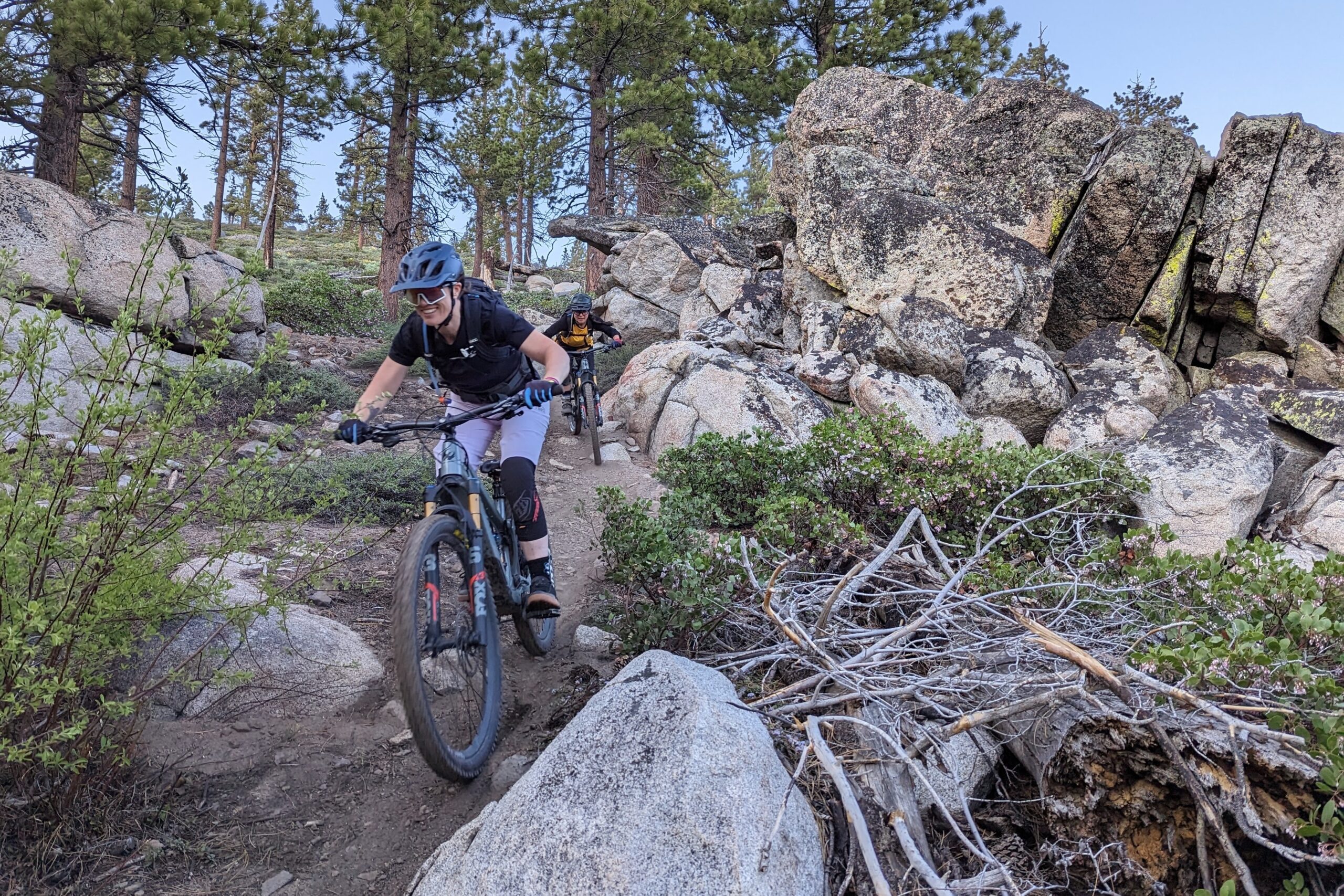
Buying Advice: How To Choose Women’s Mountain Bike Shoes
In the women’s mountain bike shoe market, we’ve got quite a few options to choose from. Getting shoes that fit properly is obviously an incredibly important piece of the puzzle, and beyond that, finding shoes that work well for your riding style (or styles) and work with your pedals of choice (clipless or flats) will help you narrow down the options to find what you need.
What Type of Pedals Do You Use?
This is pretty obvious, but it’s critical to get shoes that are designed to work with the pedals you use or intend to use. In mountain biking, these are either flat pedals or clipless (clip-in) pedals, and shoes are specifically designed to work with one or the other. Pedal choice is typically based on personal preference with most riders choosing one or the other and some people using both depending on the type of riding they’re doing. We go into a little more detail about the pros and cons of both pedal styles in the FAQ section below.
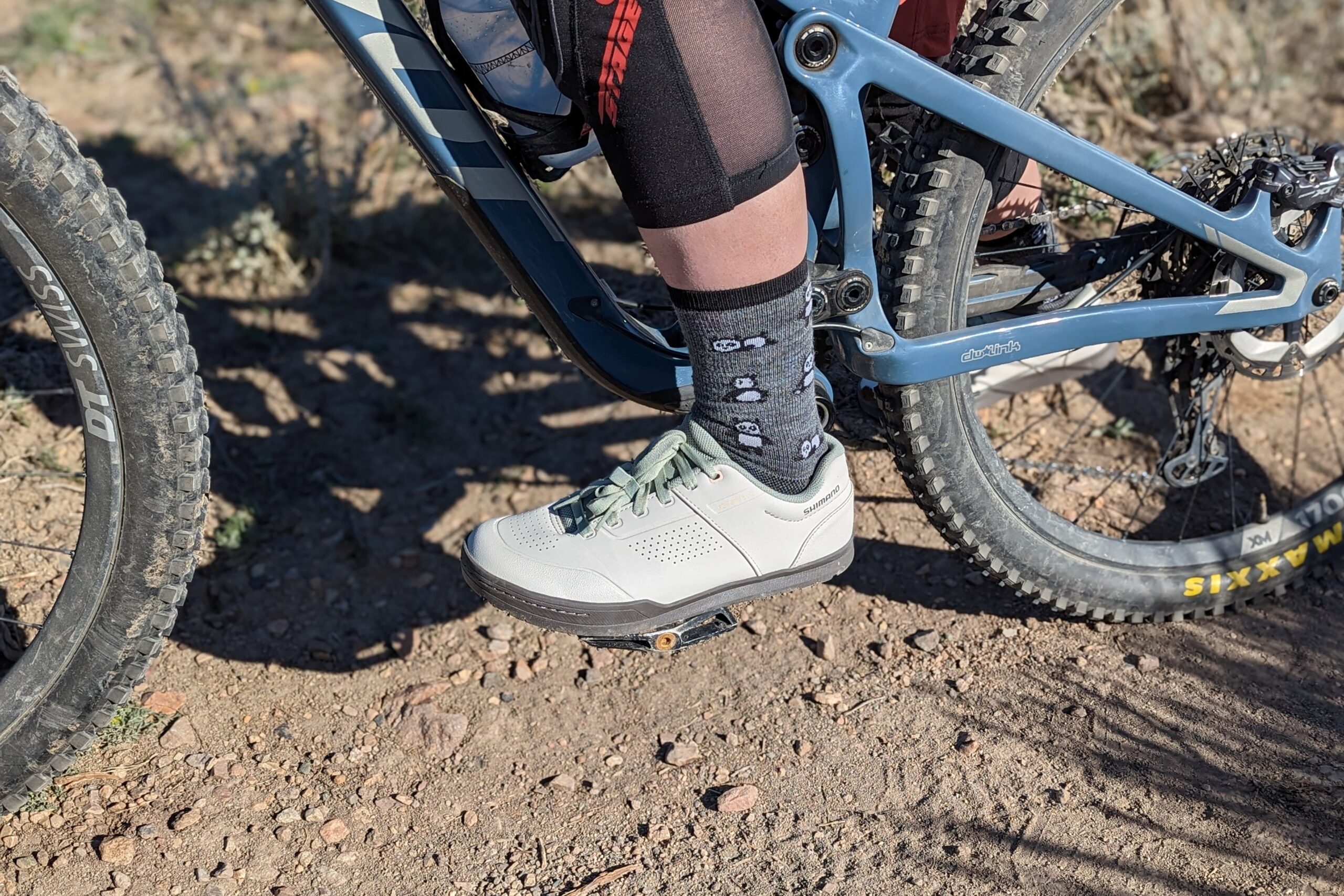
Flat pedal shoes are made to work with flat, or platform, pedals and they typically feature flat soles covered edge to edge with a grippy rubber compound and a shallow tread design intended to interface well with the platforms and traction pins of modern flat pedals. Flat pedals and the accompanying shoes are chosen by many riders, from beginners to professionals, for a variety of reasons and they are suitable for everything from trail riding to downhill, enduro, and dirt jumping. Some people even ride with flat pedals on gravel and XC bikes. The four flat pedal shoes we tested are the Giro Latch, Ride Concepts Livewire, Five Ten Freerider Pro, and the Shimano GR5. Additionally, we’ve tested and reviewed unisex and men’s flat pedal shoes if you’re interested in learning more about other options.
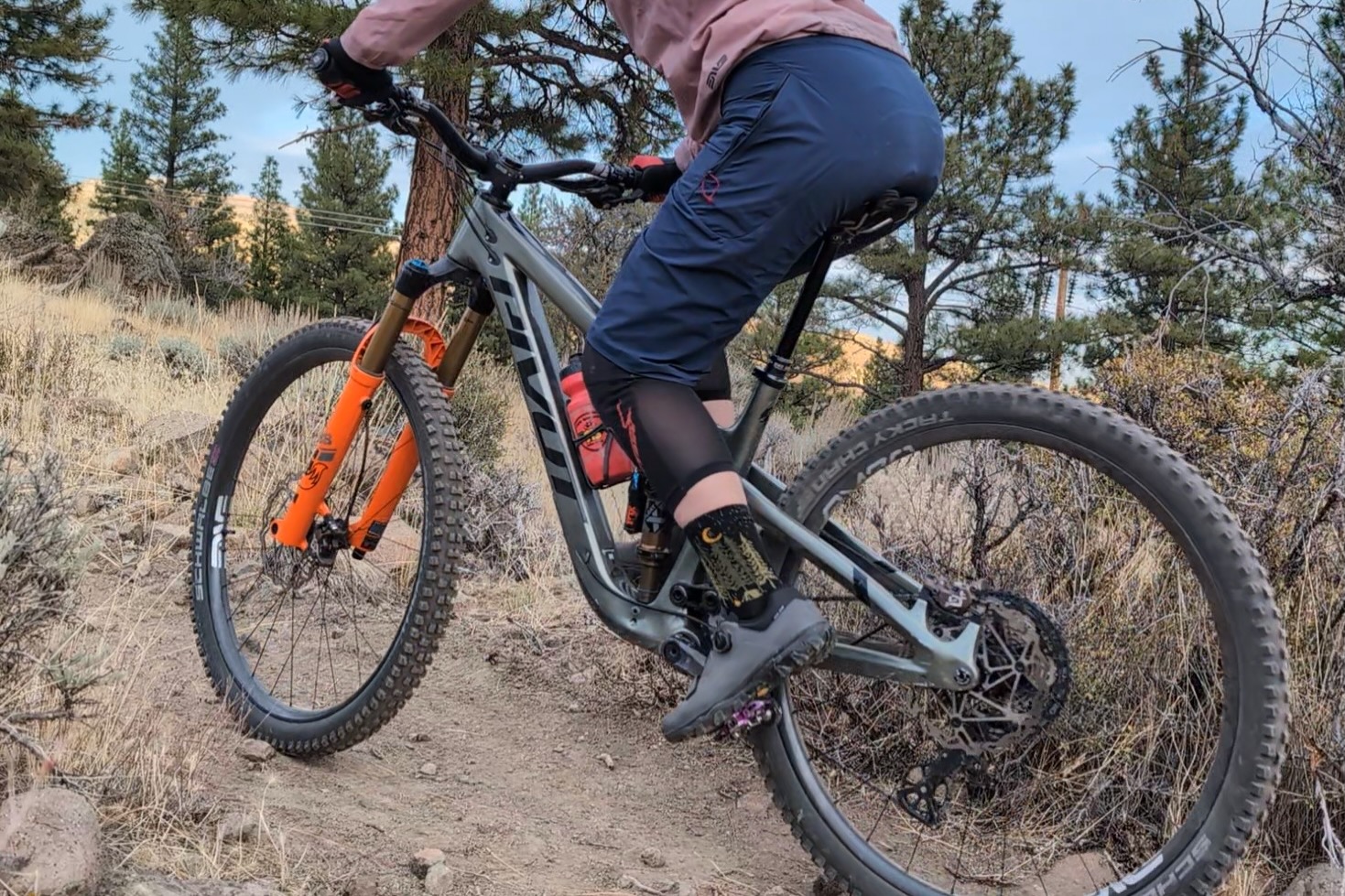
Clipless mountain bike pedals require shoes that are specially designed to accept a metal cleat that attaches to the sole of the shoe and clips into the retention mechanism on the pedal. This provides a mechanical connection to the pedal that keeps your feet in place and can help maximize your pedaling power throughout the whole pedal stroke. The soles of clipless shoes are generally a little bit stiffer than those on flat pedal shoes which can help to enhance pedaling efficiency further. For these reasons, clipless shoes are typically the choice of XC and gravel riders looking to get the most out of their pedaling effort. They are also popular among trail and gravity riders who prefer a “locked-in” connection feel to their pedals. The clipless shoes we tested are the Giro Sector, Shimano XC3, Scott MTB Comp Boa, Pearl Izumi X-Alp Summit, and Ride Concepts Hellion Clip. There are also lots of other unisex and men’s clipless mountain bike shoes for those interested in other options.
What Type of Riding Do You Do?
Equally important to matching your shoes with your pedals is getting shoes that suit the type of riding you do. It stands to reason that the needs of someone riding downhill at the bike park are much different than someone who is cranking out miles on a lightweight short-travel bike, and there are shoes made to suit the performance needs of different riding styles.
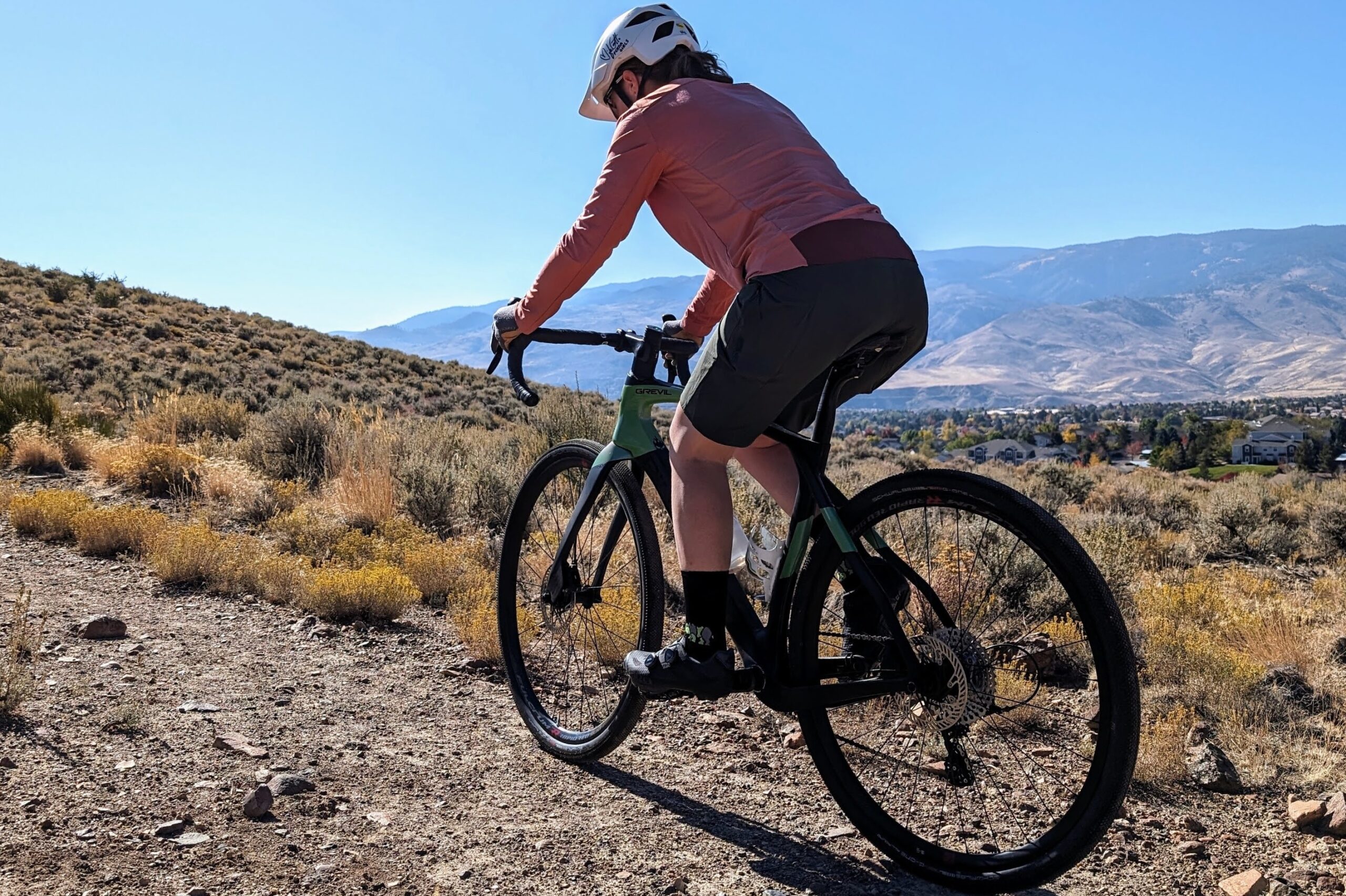
If you’re a trail, XC, or gravel rider who prioritizes efficiency on the bike, then a clipless shoe with a relatively stiff sole is likely the best bet. These types of shoes are typically lightweight, have sleek designs for a secure fit, and relatively rigid soles that help maximize your pedaling energy throughout the pedal stroke since you are clipped in. They sacrifice a bit in terms of foot protection and walkability, but they still do okay in both departments. Shoes like the Giro Sector, Shimano XC3, and the Scott MTB Comp Boa are geared toward this type of riding.
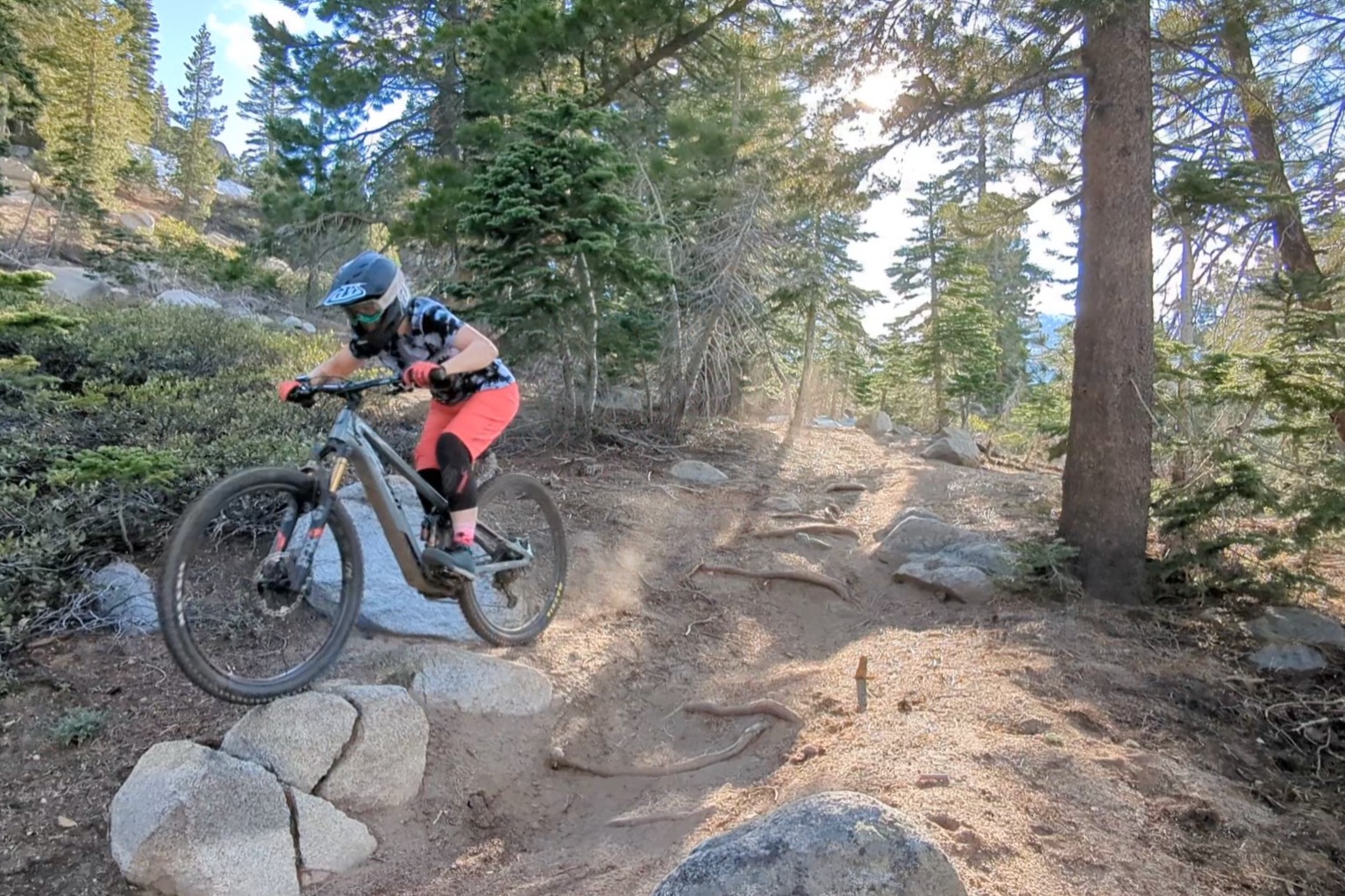
If you’re an aggressive trail rider, enduro racer, or downhiller, then you might prefer something with a bit more of a downhill focus like a versatile flat pedal shoe or clipless all-mountain shoe. These shoes tend to put more of an emphasis on foot protection with thicker upper materials and reinforced areas along with vibration-dampening midsoles made of EVA foam or similar materials. The soles of these types of shoes tend to be a bit softer flexing, though still supportive enough for pedaling and descending. Flat pedals and flat pedal shoes are preferred by many for these styles of riding, although there are lots of clipless shoes on the market with similar looks and performance characteristics for those who prefer to clip in.
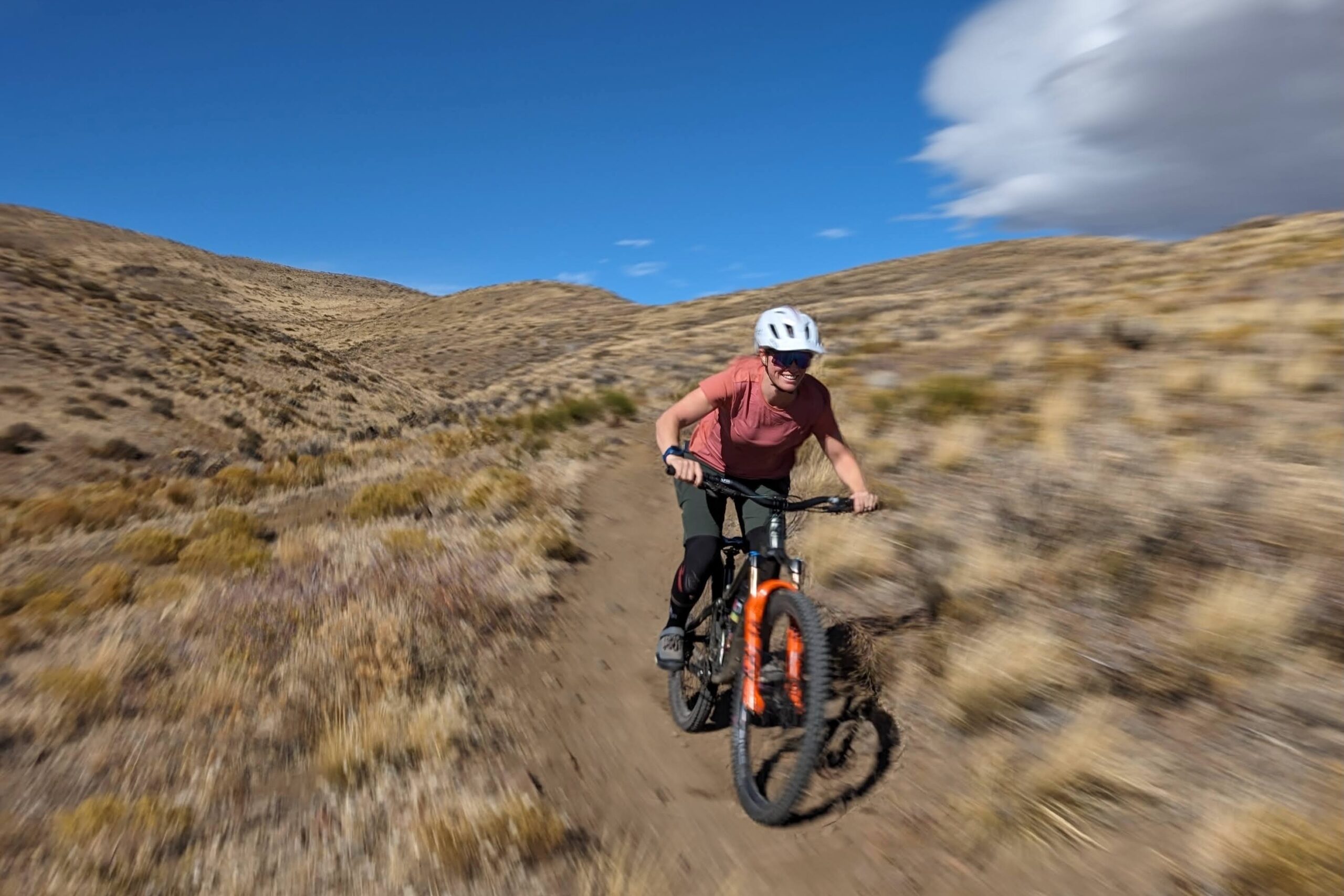
Fit
Like any athletic footwear, ensuring that your mountain bike shoes fit well is important for both comfort and performance. Ideally, we want that “just right” fit that is snug and secure and avoids being either too tight or too loose. Too tight and they can restrict blood flow, cause hot spots, and generally cause discomfort that can be distracting. Too loose and your feet can move around resulting in a reduction of control and/or pedaling efficiency as well as discomfort caused by the foot moving and rubbing against parts of the shoe. But get the fit just right, and your shoe should feel like an extension of your foot and go virtually unnoticed while riding.
Finding shoes that fit perfectly isn’t always easy since everyone’s feet are shaped differently and sizing isn’t necessarily consistent between brands. Most brands provide size charts on their websites that are typically fairly accurate and can steer you in the right direction, and taking a few quick measurements can be helpful in determining your correct mountain bike shoe size. Whenever possible, trying shoes on at your local bike shop before you buy is the best way to make sure they’ll fit properly, just be sure to wear your biking socks when you do as sock thickness can have a significant effect on the way a shoe fits. They may be able to provide assistance and suggestions and they’ll probably appreciate your business. If ordering online, make sure there’s a good return or exchange policy in case you need to send them back or swap them for a different size.
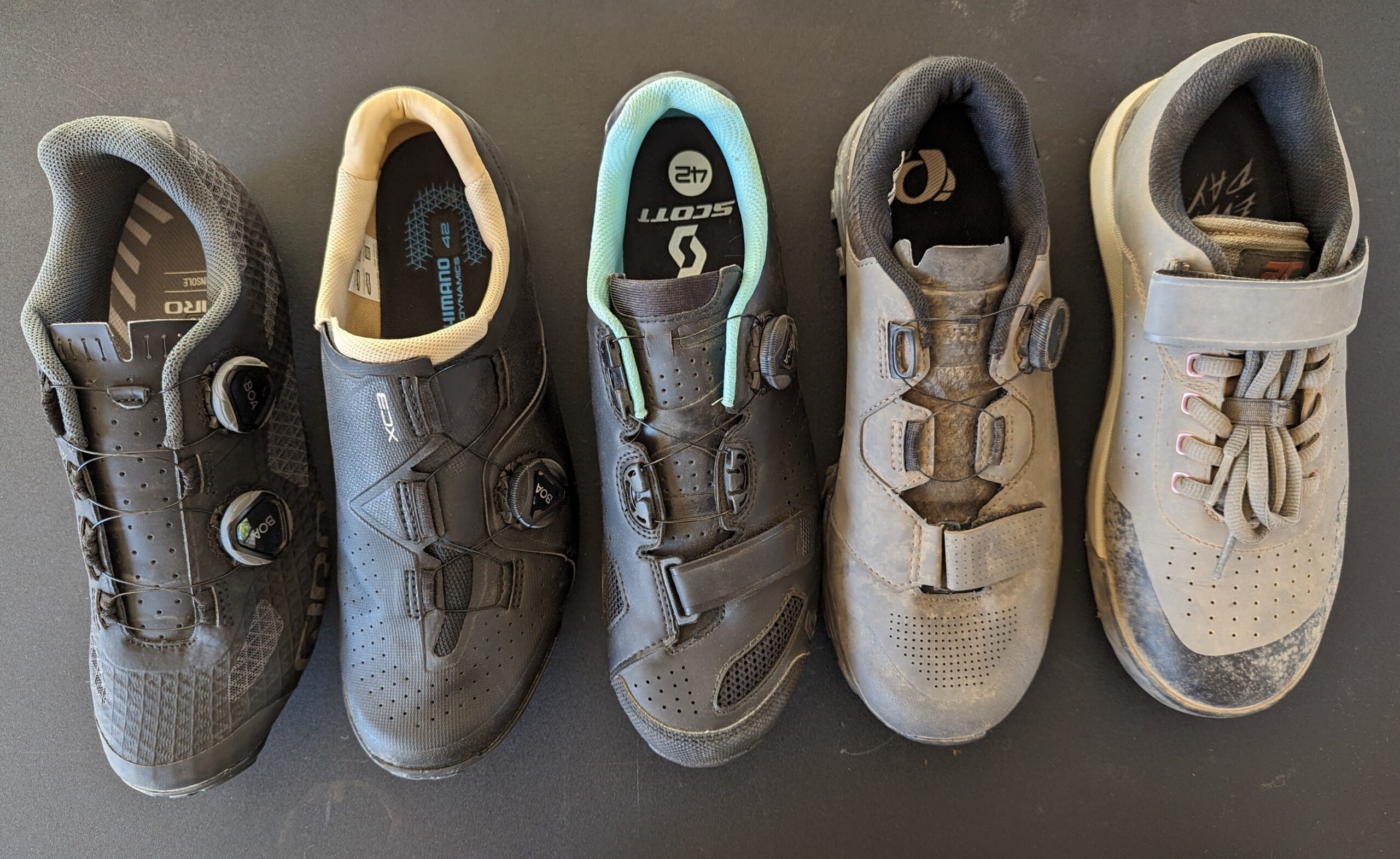
Closures
Modern mountain bike shoes go about tightening the shoes around your feet in different ways. Traditional laces and Boa dials are among the most popular, and they are often used in conjunction with a velcro/hook and loop strap. Laces are the most common on flat pedal shoes, although many clipless models use them as well, and allow for a relatively customizable fit. Laces have classic looks and are cheap and easy to replace if damaged, but they are a little more time-consuming to use when putting shoes on, taking them off, or adjusting the tension mid-ride. Boa dials are more common on clipless pedal shoes, although they are gaining popularity on flat shoes as well, and they use thin wires and ratcheting dials to pull tension over the feet. Boa closures make it very quick and easy to get shoes on and off and make mid-ride tension adjustments but they can be damaged (reliability and durability is improving, however) and they can increase the cost of a pair of shoes, comparatively speaking.
Outsole
The outsoles of your mountain bike shoes are also an important consideration. This is especially true for flat pedal shoes where we depend on the rubber compound and tread to provide grip on our pedals, but it matters on clipless shoes as well.
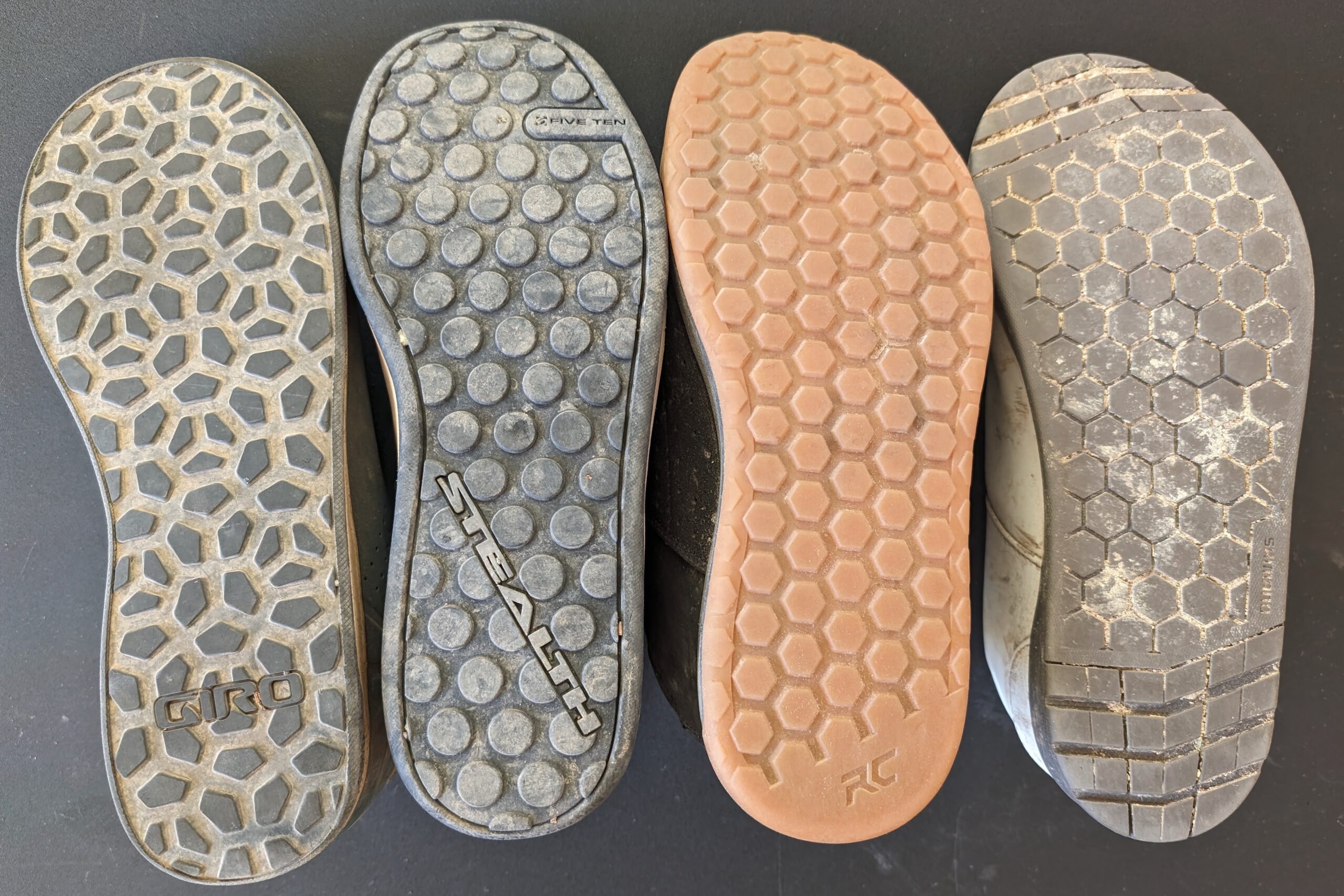
Flat pedal shoes usually have a broad, flat sole that is completely covered in rubber and typically features a relatively shallow tread pattern. One of the main goals of these soles is to interface with your pedals and provide grip both when pedaling and descending. Different brands use different rubber compounds with the same goal allowing the pins to sink in slightly to provide a good, consistent connection with the pedal to keep your feet in place. Generally speaking, the softer the rubber, the tackier or grippier it feels. Five Ten set the standard by which all other flat pedal shoes were judged many years ago with their Stealth rubber compounds, and other brands have been slow to catch up. Recently, however, other brands have cracked the code and we feel that the Tack rubber on the Giro Latch W’s and the Ride Concepts Max Grip compound on the Livewire W’s are competitively grippy. Most flat pedal shoes are relatively easy to walk around in and provide good grip on firm surfaces, although most tend to be a little slippery in mud, snow, and loose dirt given the shallow tread designs.
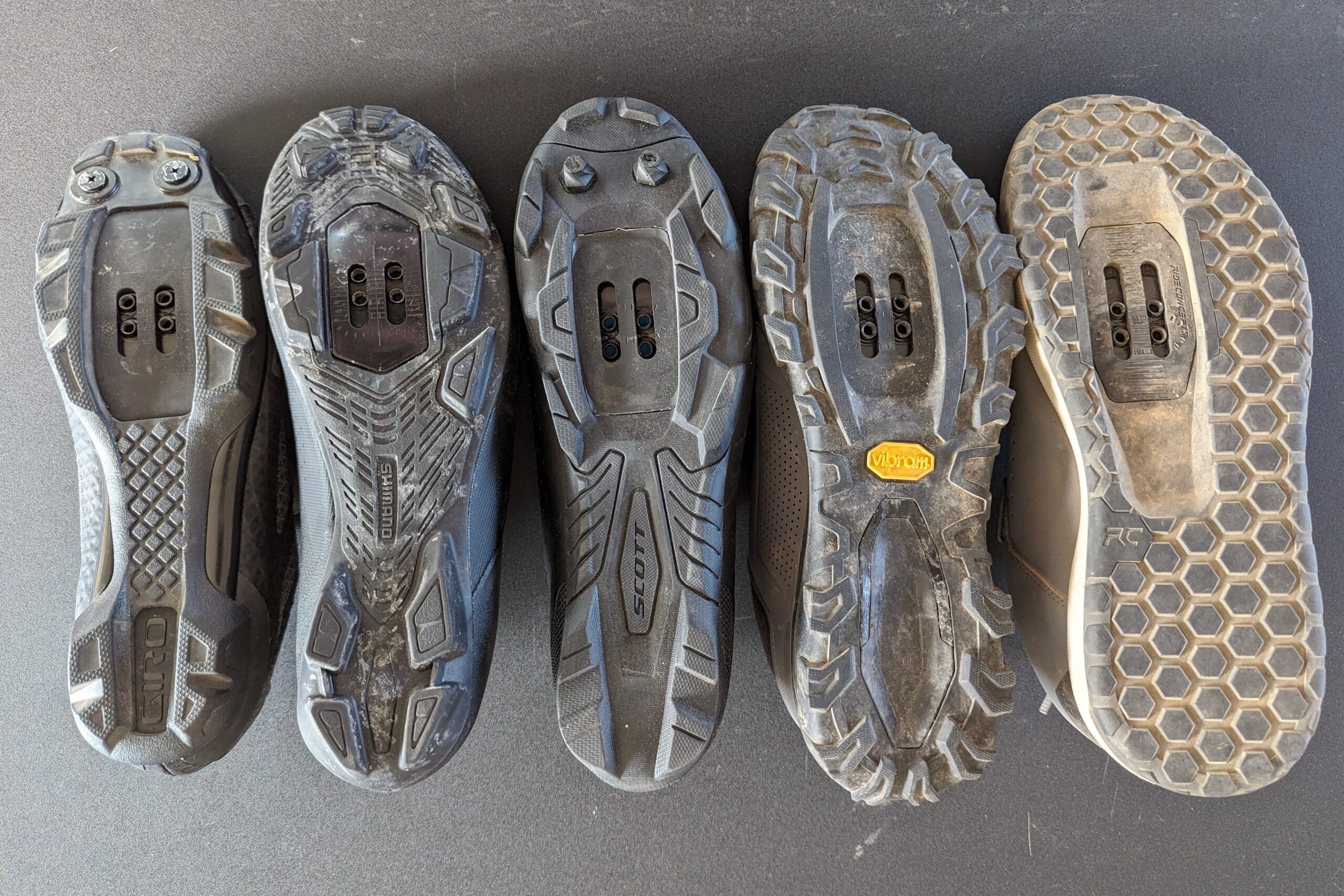
Outsole designs on clipless shoes vary more dramatically as the sole isn’t as critical for keeping the foot in place on the pedal. XC-style shoes typically have a lugged sole with more defined rubber tread blocks under the heels and on the sides of the cleat box. These designs tend to walk reasonably well off the bike and bite into loose soils but the comparatively stiffer soles aren’t the best for extended periods of walking or hiking. Clipless all-mountain or gravity shoes, like the Ride Concepts Hellion Clip, often have similar soles to their flat pedal counterparts with full coverage rubber except for the open cleat box. Adventure riding shoes often have a more hike-friendly outsole like the Vibram rubber and aggressively lugged sole on the Pearl Izumi X-Alp Summit.
Value
Mountain bike shoes come at a range of prices with higher performance shoes made with fancier materials, more advanced constructions, and the latest and greatest features typically commanding a higher price. The most expensive model we tested, the Giro Sector, is a great example. These shoes are made from a unique Synchwire material and feature stiff, carbon composite soles and dual Boa dials. The Sector is a performance shoe that’s made to provide a high level of comfort while maximizing efficiency and is suitable for everyone from XC enthusiasts to racers. In that same category of shoe but on the other end of the price spectrum, the Shimano XC3 has similar looks but a toned-down sole stiffness that’s not quite race-ready but still plenty adequate for mode recreational riding, and that’s reflected in the lower price.
Among flat pedal shoes, the price differences aren’t quite as extreme with the models we tested ranging in price between $110 and $160. In general, flat pedal shoes are a little simpler in terms of design and construction and that is reflected in the price. We think the Giro Latch and the Five Ten Freerider Pro offer the best all-around performance, but even the $110 Ride Concepts Livewire does a great job and will save you some cash (assuming they fit you right).
Frequently Asked Questions
There aren’t huge differences between men’s and women’s mountain bike footwear, but there are some. One of the biggest considerations is sizing as women’s feet are generally smaller than men’s, on average. As such, women’s shoes typically come in a size range that is comparatively smaller than men’s. For example, the Scott MTB Team Boa Women’s shoe comes in sizes 36 – 42 EU, whereas the Men’s version is offered in sizes 40 – 48 EU. Likewise, the women’s version of the Five Ten Freerider Pro comes in sizes 5 – 11 US Women’s, while the Men’s version comes in sizes 6 – 15 US Men’s. For those with feet smaller than a size 5 US Women’s, a few brands, like Ride Concepts and Five Ten, thankfully make Youth versions of some of their models.
Some women’s shoes also have a “women’s” fit or last. Generally speaking, women’s feet may be more slender and slightly narrower in the heels compared to men’s, and some shoes are designed to fit that foot shape better. Again, this is a generalization that certainly doesn’t apply to all.
Lastly, colors. Many women’s shoes are offered in several color options that include both muted tones and more feminine options like shades of pink or purple that are generally not found in men’s models.
Absolutely. Assuming they fit you well, of course. Not too long ago, the bike industry made a major push towards women’s specific products with many brands making women’s models of bikes, helmets, shoes, and other accessories. Over the past several years, however, many brands have consolidated their product lines and done away with women’s shoe models in favor of unisex options with a broader size range to fit those with smaller feet. Since the primary differentiating factors between men’s and women’s models of shoes are usually size range and color options, the shift towards unisex models and sizing isn’t a huge surprise. And, since one of the most important aspects of a shoe is that it fits well, a unisex, men’s, or women’s model should all provide a similar level of performance and comfort assuming they are the right length, width, and volume for your feet.
Not all brands have jumped on the unisex bandwagon, however, as all of the shoes in this review are, in fact, women’s models. Ride Concepts, Five Ten, Giro, Shimano, and others, still make women’s models with the primary differences being that shoes come in smaller sizes, more feminine colorways, and some have a “women’s” fit. That said, we have tested lots of the best men’s and unisex clipless mountain bike shoes and flat pedal mountain bike shoes if you’re interested in learning more about models that are not included in this buyer’s guide.
While you can mountain bike in just about any pair of shoes that you like, we prefer riding in shoes that are purpose-built for the task. Mountain bike shoes for both flat and clipless pedals are made with features, constructions, and materials that make them much better suited to riding a mountain bike than any pair of running sneakers or hiking boots.
How the shoes interface with your pedals is one of the main benefits of mountain bike shoes whether you clip in or ride flats. For flat pedals, shoes have outsoles that are designed to have a broad platform underfoot where they contact the pedal body and pins along with grippy rubber to provide a solid connection between the sole and pedal. Shoes designed for clipless pedals feature a range of outsole designs but they always have a channel in the sole with two small tracks backed by a cleat plate where you mount the cleat used to clip into a clipless pedal.
Support is another of the primary benefits of mountain bike shoes. While the soles of mountain bike shoes vary in stiffness depending on their type and intended use, they are typically much stiffer, and therefore more supportive, than a pair of running shoes, for example. These soles support the feet more both when pedaling and descending, helping to prevent the feet and calves from getting fatigued. In general, shoes designed for XC-style riding and efficiency tend to have stiffer soles while shoes designed for use with flat pedals are a bit softer flexing for added grip and pedal feel. Similarly, the uppers are designed to provide support for the feet which is critical for both comfort and control.
Mountain bike shoes are also made with robust materials and constructions so they can take the abuse associated with being attached to your feet while riding a bike through the forest. This includes tough, seamless synthetic leather and similar materials, rugged rubber soles, quality craftsmanship, and refined designs. Additionally, most mountain bike shoes make an attempt to provide a bit of added protection for the feet in the form of reinforced heel cups, toe boxes, strategically placed padding, and cushioned midsoles. Protective features vary depending on the model and intended use, of course.
The age-old debate between clipless and flat pedals is one that will likely rage on forever. The thing is, there is no right or wrong pedal type to use. You should choose whatever works best for you and you’re most comfortable using. Most people choose one or the other and some people ride both, switching between pedal types depending on the type of riding they are doing. There are, however, benefits and drawbacks to the different types of pedals which we will detail below.
Clipless pedals:
Clipless pedals provide a mechanical connection between your shoe and the pedal with a small cleat attached to the bottom of your shoe and a clip/retention mechanism on the pedal itself. They come in a range of styles including small lightweight options with no cage/platform, “trail” pedals with a mid-sized cage/platform, and “gravity” models with larger cages/platforms surrounding the clip mechanism. The benefits of clipless pedals are that when set up properly, they keep your foot on the pedal in the optimal position and are claimed to be more efficient for pedaling as you maximize your pedaling power on both the up and downstrokes of each rotation. Since your foot is attached to the pedal, it is also much less likely to come off the pedal unexpectedly over rough terrain or while jumping, etc. Being connected to the pedal can also be a handling benefit for some riders as it allows them to pull up on the bike with their feet to jump over obstacles or climb up over ledges, etc.
The drawbacks to clipless pedals are that they take some getting used to when clipping in and out, and when learning it can result in some pretty awkward crashes. It becomes second nature over time, but there is definitely a learning curve. It is also less convenient to put a foot out and back on the pedal through corners or technical sections given the need to clip in and out of the pedal. Walking in shoes with cleats can also be a little less pleasant given that there is a piece of metal attached to the sole and the soles themselves are typically quite stiff, though walkability varies depending on the model and style. Many people will also argue that riding clipless pedals teaches you poor technique given that you can rely on your connection to the pedals for certain things.
Flat Pedals:
Flat pedals, or platform pedals, provide support for the foot with a larger pedal platform/body and grip the soles with strategically placed pins. While they all share the same basic shape and design, flat pedal models differ with varying platform sizes, profiles, thicknesses, pin layouts, etc, to provide different performance characteristics out on the trail. Flat pedal shoes generally have wide, flat soles with fairly shallow treads and grippy rubber intended to provide a friction-based connection to the pedal and its pins. The benefits of flat pedals are that it’s very easy to place your foot on and remove it from the pedal. You also have more freedom and mobility so you can shift your feet around into different positions more freely should you like to adjust them for different situations. It is also claimed that riding flat pedals forces you to learn better riding technique since you can’t rely on the crutch of being attached to your pedals all the time.
The drawbacks to flat pedals are that they are claimed to be slightly less efficient for pedaling than clipless pedals because they don’t allow you to pull up on the pedals in the same way during the pedal stroke. Since your feet are not mechanically connected to the pedals, it is also possible to unexpectedly “slip” a pedal or get bounced off the pedals over rough terrain (depending on your technique and shoe/pedal combo, of course). Pedal pins are also quite sharp, so a pedal to the shin or calf can be incredibly dangerous and painful. We’ve got friends who look like their lower legs have been attacked by bears…
The term clipless is a bit of a misnomer, but it goes back a few decades. Before clipless pedals existed and properly grippy flat pedals came about, mountain bike pedals often had toe clips or cages, that extended from the front of the pedal and up over the toe of your shoes to keep your feet connected to the pedals and to prevent them from slipping off the front. When the first clip-in SPD pedals came about, they didn’t have a toe clip and became known as “clipless” as a result. So, the term clipless is undoubtedly confusing given that you clip in to a clipless pedal. These days, many shoes have the words “clip” or “clip-in” added to the name, which is a little more clear.
